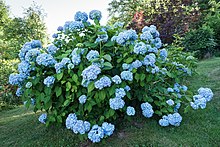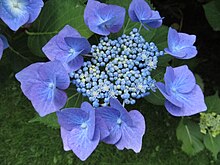Hydrangeas
| Hydrangeas | ||||||||||||
|---|---|---|---|---|---|---|---|---|---|---|---|---|

Forest hydrangea or tree hydrangea ( Hydrangea arborescens ), inflorescence |
||||||||||||
| Systematics | ||||||||||||
|
||||||||||||
| Scientific name | ||||||||||||
| Hydrangea | ||||||||||||
| L. |
The hydrangeas ( Hydrangea ) are a genus of plants in the hydrangea family (Hydrangeaceae). Varieties of some of their species are popular ornamental shrubs . The most famous in Central Europe is the garden hydrangea .
What is noticeable about their inflorescences are not so much small, fertile flowers as rather sterile show flowers with large, colored or white sepals that stand on the edge of the inflorescence; In the cultivated forms of the garden hydrangea , all the flowers have enlarged sepals and are sterile.
etymology
The term hydrangea comes from the Latin hortensius (derived from hortus for garden) with the meaning "belonging to the garden, garden". Philibert Commerson , who created the plant name, wanted either the French mathematician and astronomer Nicole-Reine 'Hortense' Lepaute born with this name . Étable de la Brière (1723–1788) or his lover and partner, Jeanne Baret (1740–1803), a French naturalist - probably the first woman to sail around the world - who disguised him as a man during the period from 1766 to 1769 Tour around the world accompanied by Louis-Antoine de Bougainville .
description
In hydrangea species is woody plants: Half bushes , shrubs , small trees or vines . There are both evergreen and deciduous species. The hairiness can also be very different depending on the species.
The leaves are opposite , rarely lively . In most species, the leaf blade is simple, large and serrate on the edge. However, there are also species with a smooth leaf margin or with pinnate leaves. Stipules are missing.
The umbellate zymous or thyrsen-shaped inflorescences are usually terminal, only occasionally an axillary inflorescence appears. The bracts in the inflorescences fall off early. It is typical of the genus Hydrangea that in most species in a cyme , i.e. in most species in an inflorescence, there are sterile flowers on the edge and numerous fertile flowers inside . However, there are also species without sterile flowers.
The short-stalked flowers are small and hermaphrodite. The sterile flowers have two to five, in many species four kronblattartig enlarged, whitish to reddish or purple sepals . The short stalked fertile flowers, however, are inconspicuous. They have four to five sepal lobes and four to five small, dome-shaped, free or less often fused petals. In many garden forms, however, the fertile flowers are completely absent. There are usually ten (rarely eight or 25) stamens present. The two to four (rarely five) styles are free.
There are fruit capsules formed. The small seeds are winged or wingless. The coloring is caused by anthocyanins ( delphinidin ).
Occurrence
The hydrangea species of the genus are mostly found in temperate to warm areas of East Asia. Only a few species also come from Southeast Asia, North and South America and the Azores. There are 33 species in China, 25 of them only there.
The majority of the species grow as undergrowth in forests.
Systematics
The genus Hydrangea was established in 1753 by Carl von Linné in Species Plantarum , Volume 1, p. 397. Type species is Hydrangea arborescens L. Synonyms for Hydrangea L. are: Calyptranthe Nakai , Cornidia Ruiz & Pav. , Hortensia Comm. ex Juss. , Sarcostyles C. Presl ex DC.
The genus Hydrangea belongs to the tribe Hydrangeae in the subfamily Hydrangeoideae within the family Hydrangeaceae . It used to be part of the Saxifragaceae family.



The genus Hydrangea contains around 70 to 80 species (selection):
- Hydrangea anomala D.Don , also known as the climbing hydrangea. It occurs in Bhutan, India, Myanmar, Nepal, Japan, Taiwan and China.
- Forest hydrangea or tree hydrangea ( Hydrangea arborescens L. )
- Rough hydrangea ( Hydrangea aspera D.Don )
- Hydrangea bretschneideri Dippel (Syn .: Hydrangea heteromalla 'Bretschneideri'): It occurs in Gansu, Hebei, Henan, Ningxia, Qinghai, Shaanxi and Shanxi.
- Hydrangea chinensis Maxim. (Syn .: Hydrangea scandens subsp. Chinensis (Maxim.) EMMcClint. ): It occurs in Japan and China.
- Hydrangea cinerea Small : It is found in the eastern and northern United States.
- Hydrangea chungii Rehder (Syn .: Hydrangea macrophylla subsp. Chungii (Rehder) EMMcClint. ): It occurs in northwestern Fujian.
- Hydrangea davidii Franch. (Syn .: Hydrangea yunnanensis Rehder ): It occurs in Guizhou, Sichuan and Yunnan.
- Hydrangea dumicola W.W.Sm. : It occurs in western Yunnan at altitudes between 1900 and 2500 meters.
- Chinese hydrangea ( Hydrangea heteromalla D.Don ): It occurs in Bhutan, northeast India, Nepal, Sikkim and Xizang, Sichuan and Yunnan at altitudes between 2,400 and 3,400 meters.
- Hairy hydrangea ( Hydrangea hirta (Thunb.) Siebold ): It occurs in Japan on the islands of Honshū, Okinawa and Shikoku.
- Hydrangea integrifolia Hayata : It occurs in the Philippines and Taiwan.
- Bract hydrangea ( Hydrangea involucrata Siebold )
- Hydrangea kwangsiensis Hu : It occurs in northern Guangdong, northern Guangxi, southeastern Guizhou and southeastern Hunan.
- Hydrangea liukiuensis Nakai : It occurs on the Ryūkyū Islands .
- Hydrangea longipes Franch. : It occurs in Gansu, Guizhou, Hebei, Henan, Hubei, Hunan, Shaanxi, Sichuan and Yunnan.
- Hydrangea luteovenosa Koidz. : It occurs in Japan on Honshū, Kyushu and Shikoku.
- Garden hydrangea ( Hydrangea macrophylla (Thunb.) Ser. )
- Panicle hydrangea ( Hydrangea paniculata Siebold )
- Climbing hydrangea ( Hydrangea petiolaris Siebold & Zucc. )
- Oak-leaved hydrangea ( Hydrangea quercifolia W.Bartram )
- Hydrangea radiata Walter : It occurs in Georgia, North Carolina, South Carolina and Tennessee.
- Hydrangea robusta hook. f. & Thomson EMMcClint. : It occurs in Bangladesh, Bhutan, northern India, Myanmar, Sikkim and China.
- Hydrangea sargentiana Rehder : It occurs in western Hubei.
- Hydrangea scandens (L. f.) Ser. : It occurs in Japan on Honshū, Kyushu and Shikoku.
- Hydrangea seemannii L. Riley : It occurs in the Mexican state of Durango.
- Sawn hydrangea ( Hydrangea serrata (Thunb.) Ser. ): It occurs in Japan and on Jejudo .
- Hydrangea serratifolia (Hook. & Arn.) F.Phil. : It occurs in Argentina and Chile.
- Hydrangea strigosa Rehder : It occurs in northwestern Guizhou, western Hubei, northwestern Hunan, southern Shaanxi and Sichuan.
- Hydrangea stylosa Hook. f. & Thomson : It occurs in Bhutan, Myanmar, Sikkim and in western Yunnan at altitudes between 2700 and 3000 meters.
- Hydrangea xanthoneura Diels : It occurs in Guizhou, northwestern Hubei, Sichuan and Yunnan.
Hydrangeas as ornamental plants
The breeding and cultivation of hydrangeas as ornamental plants began in German-speaking countries as early as the 18th century. Commercial cultivation reached its heyday in the Federal Republic in the early 1960s. At that time, agriculture and horticulture were producing almost 7 million hydrangeas. After a low in the 1980s, production recently rose again. This was made possible “by a greater variety of colors, shapes and habitus”. In general, the hydrangea is now considered an easy-care plant for the house and garden, which is characterized by great external diversity and good durability. Wintering is also possible outside the home, depending on the variety. Appropriate winter protection of the plants is recommended, depending on the species. Propagation takes place through cuttings and cuttings.
Use as a drug
In parts of the German journalist scene there is a rumor that certain parts of the plant develop a cannabis-like effect when smoked. This has not been scientifically proven, it seems to be a mere rumor that is warmed up every year to the summer slump. There are no known psychoactive substances in the plant. In fact, when smoking, highly toxic hydrogen cyanide would be released from the plant, which can lead to poisoning, blockage of the respiratory chain and the destruction of the central nervous system and even death. We therefore strongly advise against smoking the parts of the plant. Because of the rumors that the plant can be used as a drug, hydrangeas are stolen again and again, especially from private gardens.
swell
literature
- Jin-tang Pan, Cuizhi Gu, Shumei Huang, Chao-fen Wei, Shu-ying Jin, Lingdi Lu, Shinobu Akiyama, Crinan Alexander, Bruce Bartholomew, James Cullen, Richard J. Gornall, Ulla-Maj Hultgård, Hideaki Ohba, Douglas E. Soltis: Saxifragaceae. - hydrangea. In: Wu Zheng-yi, Peter H. Raven (Ed.): Flora of China. Volume 8: Brassicaceae through Saxifragaceae. Science Press / Missouri Botanical Garden Press, Beijing / St. Louis 2002, ISBN 0-915279-93-2 , pp. 411-422. (Section description, distribution and systematics)
- Andreas Roloff , Andreas Bärtels: Flora of the woods. Purpose, properties and use. With a winter key from Bernd Schulz. 3rd, corrected edition. Eugen Ulmer, Stuttgart (Hohenheim) 2008, ISBN 978-3-8001-5614-6 , pp. 336-341.
- Jost Fitschen : Woody flora . 12th, revised and expanded edition. Quelle & Meyer, Wiebelsheim 2007, ISBN 978-3-494-01422-7 , p. 527-530 .
Individual evidence
- ↑ Lotte Burkhardt: Directory of eponymous plant names . Botanic Garden and Botanical Museum Berlin, Free University Berlin Berlin 2016. ISBN 978-3-946292-10-4 , doi : 10.3372 / epolist2016
- ↑ First publication scanned at biodiversitylibrary.org .
- ↑ Entry in Tropicos . last accessed January 30, 2012
- ↑ a b c d e f g h i j k l m Hydrangea in the Germplasm Resources Information Network (GRIN), USDA , ARS , National Genetic Resources Program. National Germplasm Resources Laboratory, Beltsville, Maryland. Retrieved September 23, 2017.
- ↑ a b c d e f g h i German names after Roloff, Bärtels: Flora of the woods. Pp. 336-341.
- ↑ a b c d e f g h i j k l m n Wei Zhaofen (Wei Chao-fen); Bruce Bartholomew: Hydrangea Linnaeus. - Same text online as the printed work , In: Wu Zheng-yi, Peter H. Raven, Deyuan Hong (Ed.): Flora of China. Volume 8: Saxifragaceae. Science Press and Missouri Botanical Garden Press, Beijing and St. Louis 2010.
- ↑ German name after Jost Fitschen : Wood flora. P. 527.
- ^ LVG Heidelberg - Agricultural Information Service [1] , accessed October 18, 2011.
- ↑ Online portal Hortensie.net [2] , accessed January 10, 2013.
- ↑ Jessen, Schulze: Botany in question and answer. Verlag H & M Schnapper: 2001, p. 271
- ↑ Gotthilf Heinrich von Schubert : Employment for the youth of all classes to get used to appropriate activity for amusing entertainment: as well as to stimulate the arts and crafts, Volume 1. Verlag der P. Balz'schen Buchhandlung: 1835, p. 92
- ↑ Federal Association of German Pharmacists' Associations, March 16, 2011: Archived copy ( memento of the original from November 6, 2016 in the Internet Archive ) Info: The archive link was inserted automatically and has not yet been checked. Please check the original and archive link according to the instructions and then remove this notice. , accessed November 6, 2016
- ^ Deutscher Hanf Verband, March 27, 2011, [3] , accessed April 6, 2011
- ↑ Flower theft in Bavaria - hydrangea joints with fatal side effects. In: Süddeutsche Zeitung. April 16, 2013.



